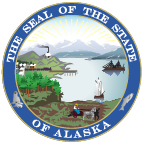The following is a greeting given in one of the 20 indigenous languages recognized by the State of Alaska.
- Ade’ ndadz dengit’a?
- Language: Deg Xinag
- Translation: "Hello, how are you?"
Time Zone
Time Zone
|
On September 15, 1983, Secretary Elizabeth Dole signed a plan to reduce the number of time zones in Alaska from four to two; two weeks later, the plan became effective. Since that date, 90 percent of Alaska residents set their clocks to Alaska Standard Time (same as Yukon), only one hour behind the West Coast. The far reaches of the Aleutian Islands and St. Lawrence Island are in the next zone, Hawaii-Aleutian Standard Time. Alaska does participate in the Daylight Savings program from April to October along with most other states in the US. Before this change, Alaska's time zones were Pacific time (southeastern Alaska), Yukon time (Yakutat), Alaska time (from just east of Cold Bay and west of Yakutat northward, including Nome), and Bering time (the north coast of Alaska and the Aleutian chain). The shift was made to facilitate doing business in Alaska, improve communications, and unify residents. |
Alaska Facts
State Nick Name: "The Last Frontier" - the name Alaska is derived from the Aleut word "Alyeska," meaning "great land."
State Motto: "North to the Future"
State Capital: Juneau, located in the Southeast region of Alaska, has a population of 33,277 (2015 Estimate of Population, Alaska Department of Labor and Workforce Development)
Alaska Map:

Alaska Flag:

NOTE: The State of Alaska is not responsible for the content/information on any site outside of a State of Alaska department.
